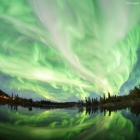Magnetic Fields at Low Temperatures: Cool Stars, Brown Dwarfs, and (Eventually) Exoplanets
The magnetic field of Earth protects its surface from cosmic rays and the solar wind, while that of Jupiter enables powerful aurorae that can be brighter than the Sun at long radio wavelengths. What are the magnetic fields of extrasolar planets like? Although direct observations are not yet feasible, the groundwork for answering this question is being laid, with an ultimate goal of characterizing magnetic properties across the spectrum of exoplanet types and even peering "inside" rocky planets to identify which ones may be geologically active. I will discuss recent exciting developments in our understanding of the magnetic properties of very low-mass stars and brown dwarfs, which turn out to be surprisingly similar to those of the Solar System planets, as well as prospects for the truly exoplanetary regime. The future is bright because radio studies of planets have very similar technical needs to those of the epoch of reionization, which have seen substantial investment in the past several years. In particular, I argue that HERA, the under-construction Hydrogen Epoch of Reionization Array, will bring us dramatically closer to achieving the first exoplanetary radio detection.

